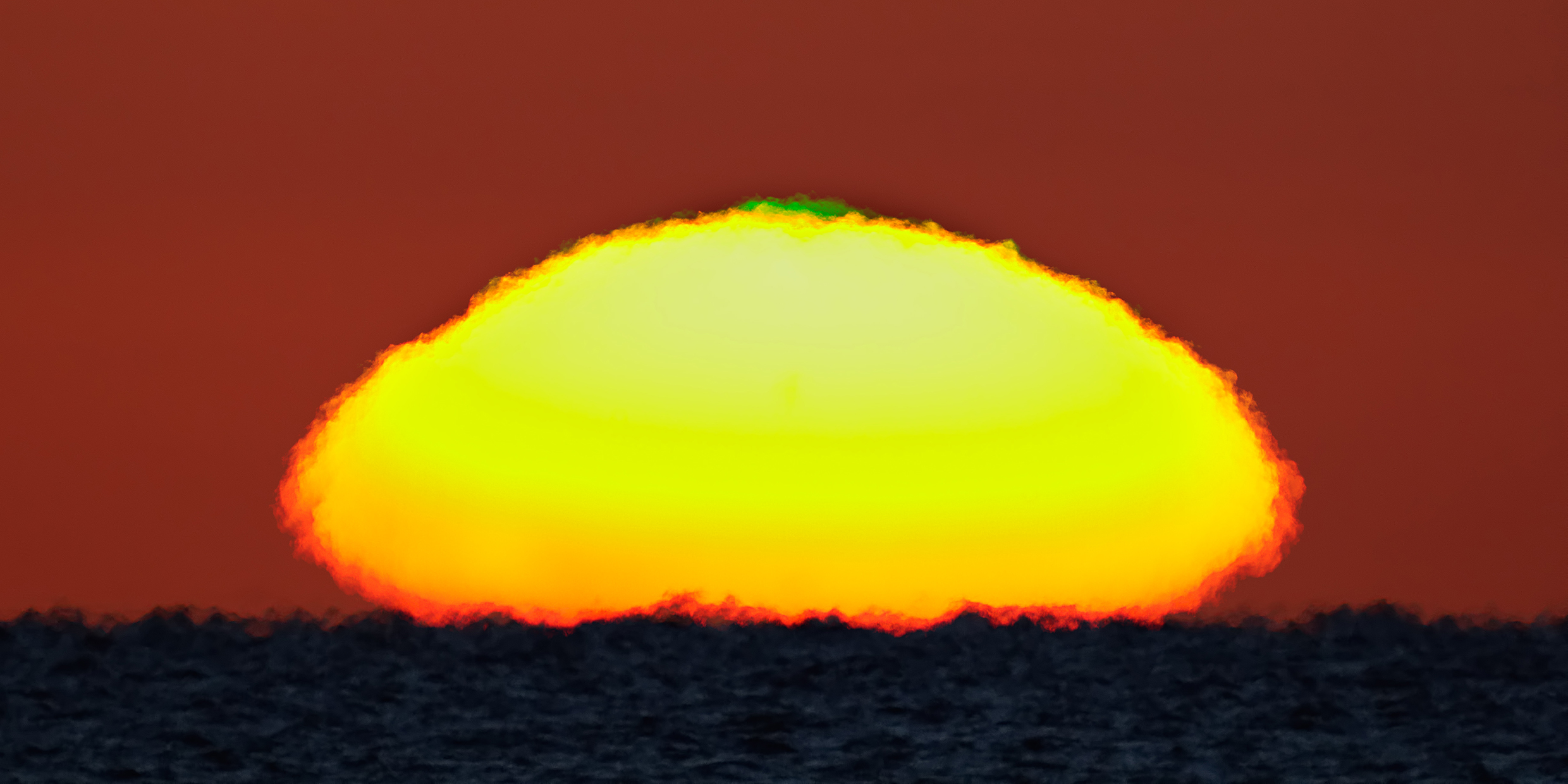Originally published 15 March 1999
EXUMA, Bahamas — Morning. The sky mostly clear to the far horizon, just a few wisps of cloud far out there over the sea where the sun will soon rise. The air is tinged pink, orange, and yellow, like layers of sugar icing on the turquoise sea.
Rays streaming upward — faint vees of light defining the place where the sun will appear. I wait, as I have waited in similar circumstances for 34 years, at sunrise and sunset, over seas and deserts, on three continents, in all seasons, north and south of the equator. For the green flash.
I have waited and watched so many times without success, that the waiting and watching has become an end in itself, a quiet time to experience the beauty of sunrise or sunset, a time to reflect upon all in the world that is inexplicable, beyond our ken.
A kind of prayer to the Deus absconditus—the hidden God.
And now the disk of the sun bubbles up on the horizon. And suddenly I am startled as the top of the disk turns emerald green — a brilliant, blazing color like none I have seen before. The green flash.
The object of all that searching, found at last.
The green flash is a momentary ray of color that sometimes appears at the top of the sun’s disk as it rises or sets on a distant horizon. The flash is caused by refraction (bending) of sunlight as it passes through the Earth’s atmosphere. The atmosphere acts like a prism, spreading the sun’s light into a spectrum, blue at the top, red at the bottom. Blue light is effectively removed from the spectrum by the great thickness of air we are looking through at sunrise or sunset (which is why the sun appears red at those times). When most of the red, orange, and yellow light in the sun’s spectrum is blocked by the horizon we see what’s left of the spectrum — the flash of green.
My long quest for the green flash began when I read an article in Scientific American in 1965 by the astronomer D.J.K. O’Connell of the Vatican Observatory. The effect described by O’Connell seemed so evanescent, so unexpected, that I determined to see it. Little did I know then how elusive it would be.
Until O’Connell’s research it was widely assumed that the green flash was a subjective phenomena or an optical illusion. Retinal fatigue was commonly held to be the “cause.” After looking into a brightly colored light our eyes get tired, and upon looking away we see the complimentary color; so, according to this theory, after looking for a while at the setting sun, which is red, we tend to see the complimentary color, green, when the sun drops below the horizon. But retinal fatigue does not explain why the flash precedes the sun at sunrise.
O’Connell’s work proved the subjective theories false. He succeeded in obtaining color photographs of the flash. The photographs were difficult to make. The band of color to be captured on film is narrow and fleeting. But the evidence on the film was indisputable. The green flash is not an artifact of the human eye. In photograph after photograph, the sun’s disk is capped with a strip of emerald green.
The green flash can only be seen if the horizon is sharply defined and the atmosphere free from haze, conditions most commonly encountered in the tropics, on coasts, in high mountains, or in deserts. Whenever I was in such places, I made sure to be watching at sunrise and sunset.
Fourteen years ago I mentioned my search for the green flash in this column, and again seven years ago. Several readers sent photographs. Others described observations of the flash from such unexotic venues as Cape Cod and the coast of Maine. One person invited me to his vacation home on a Caribbean isle where he claimed the flash was visible almost every evening (I didn’t go).
Since we started visiting this tropic island several years ago I have made it my business to anticipate sunrise. I have seen stars fade in auroral light. I have seen Venus and Mercury shining in the dawn. I have seen satellites, meteors, clouds of every shape and color, and crescent moons that were eyelash thin. But never the green flash. Until now.
In one of those earlier columns on the flash, I said that I was not altogether sorry that my search had been unsuccessful. I quoted Antoine de Saint-Exupéry’s Little Prince: “What makes the desert beautiful is that somewhere it hides a well.”
The green flash was my hidden well.
So I am a little disappointed to have seen it, but glad too. “What’s the use of praying if God does not answer?” asked the medieval mystic Julian of Norwich. If waiting and watching for the green flash for 34 years was a kind of prayer, I’ve had my answer.



